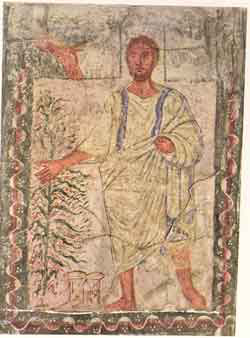The World of the Tower
The Bible begins with a series of "how did it come to be" stories: how the world and humanity were created; how paradise was lost; how crime first happened; how human occupations and crafts emerged. Woven into these stories is the disturbing role of the Creator and the dysfunction of His human creation. These aetiological legends (tales of origin) conclude with a grand finale:
These are the families of the sons of Noah, according to
their genealogies, by their nations; and out of these, the nations
branched out over the earth after the Flood
This concluding verse of Genesis 10 sets the stage for the Tower of Babel story in chapter 11, which can be understood to record how the dispersal occurred and how the world's languages came into being.
One modern translation renders the first verse of chapter 11 as follows:
The whole world had one language with a common vocabulary.
But the Hebrew actually reads "one language and a few/several words/things". Thus, our story begins with ambiguity, as befits a story about language. What is the point of the story? One suggestion is that this is a "just so story" about the amazing variety of languages and nations in the world. Another contends that the story is also a dig at pagan Babylonian culture. A third says that the story deals with hybris and its consequences. In this regard, God had already expressed grave reservations about humanity's character:
Man's creativity (yetzer lev ha-adam) inclines toward Evil from his
youth. Genesis 8:21
As discovered by J.P. Fokkelman, the story, containing all of nine verses, is ingeniously composed of recurring words structured like a tower and a ladder.
וירד יהוה לראות (5)
ו עיר ומגדל (4) (5) את העיר ואת המגדל ו'
ה נבנה לנו (4) (5) אשר בנו בני האדם יהוה
ד הבה נלבנה (3) (7) הבה נרדה ונבלה ד'
ג ויאמרו איש אל רעהו(3) (7) לא ישמעו שפת רעהו ג'
ב וישבו שם (2) (8) ויפץ יהוה אותם משם ב'
א כל הארץ שפה אחת (1) (8) על פני כל הארץ א'
א שפה אחת א' עם אחד
ודברים אחדים (1) ושפת אחת לכולם (5)
——————————————————————
ב הבה נלבנה (3) ב' הבה נרדה ונבלה (7)
——————————————————————
ג נבנה לנו עיר ומגדל (3) ג' ויחדלו לבנות העיר (8)
——————————————————————
ד ונעשה לנו שם (4) ד' על כן קרא שמה בבל (9)
——————————————————————
ה פן נפוץ יהוה ומשם הפיצם יהוה
על פני כל הארץ (4) על פני כל הארץ (9)
——————————————————————
Ascent and descent, language and architecture are hardwired into the story itself.
The Midrashic Interpretation
Many modern readers are perplexed by the question: What was sinful about the building of the Tower of Babel? In the biblical account, no clear answer is forthcoming. But Midrash is unequivocal in its condemnation of the intent to reach heaven and displace God. In Targum Yonatan we read:
And they said: Let us build a city and a tower reaching the heights
of heaven and place an idol at its top with a sword in its hand; he
will make war against Him, so that we not scatter over the face of
the earth.
This Midrash serves as the basis for Shalom of Safed's painting, which portrays the intent as a fait accompli.
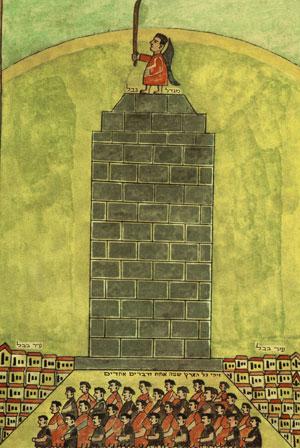
Shalom of Safed, 1960
Two additional characterizations of the people's intent are found in the Babylonian Talmud:
R. Jeremiah b. Elazar said: There were three sorts of rebels among
the builders. The first party spoke, Let us ascend into the heavens
and settle there; the second party spoke, Let us ascend into the
heavens, set up our idols, and pay worship unto them there; and
the third party spoke, Let us ascend into the heavens, and war
against Him. Sanhedrin 109a
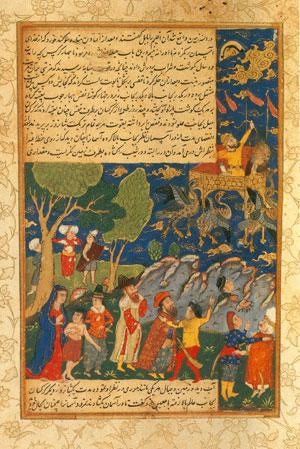
While the motif of war against God is central in Jewish Midrash, it is not found, as far as we know, in Jewish or Christian iconography. A reflex of this tradition does, however, appear in this Islamic miniature from 1600, in which Nimrod shoots arrows at God as he is lifted heavenward in a basket powered by eagles.
Fear of flooding
Alone among the commentators, Josephus writes that people built the Tower out of fear of a recurring Flood. Several artists include seascapes in their portrayals of the Tower, apparently responding, like Josephus, to the juxtaposition of the Flood and Tower stories.
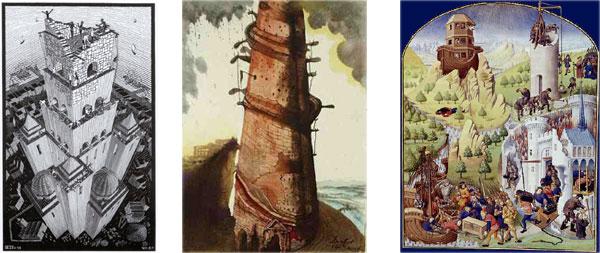
M.C. Escher, 1928 S. Dali, 1969 History of Brittany,
1480-82
Because the viewpoint in Escher's picture of the Tower is from above (God's point of view), half of its upper background is filled with waves of the nearby sea. Black storm clouds shape the heavens in Dali's Tower, also positioned beside water.
The most curious of these three pictures combines the biblical narrative and a French-Roman legend. The picture is a 15th century historical homily of the settlement of Brittany. In the upper left, Noah's Ark is perched on Mt. Ararat. Parallel with the Ark and to the right, the Tower reaches heavenward. Below right, the burning city of Troy is abandoned. Below left, the refugees board the ship that will take them to Brittany. The following parallels emerge:
Upper left – the Ark, humanity's means of rescue by and from the sea
Lower left – another ship rescues Troy's survivors by sea
Upper right – the survivors build their new city
Lower right – the survivors flee their city
Thus the "modern" inhabitants of Brittany are linked to their ancient predecessors. Just as Noah and his family escaped destruction and rebuilt their civilization, so the survivors of Troy escaped by ship to rebuild their lives in Brittany. The Tower of Babel becomes here a symbol of civilization, rather than of impious rebellion. Likewise, the Sea, rather than an agent of destruction, is an agent of salvation.
Nimrod and the Tower
An alternate view of our story, expanded both in Midrash and in art, derives from the juxtaposition of the legend of the Tower (Genesis 11) and the mention of Nimrod, twice entitled gibor (hero) in Genesis 10. The "hero" Nimrod of Genesis 10:8 and 9 becomes a giant in the Septuagint and in Philo's writings (as well as in the Aramaic Targumim). In addition, we are informed by Genesis 10:10 that Nimrod's kingdom began with Babel, the city that he built. The next step in the midrashic process connects Nimrod with the Tower of Babel; this connection already appears in the writings of Josephus, which were preserved by the Christian Church.
Josephus makes the giant a despot, paraphrasing the biblical account as follows:
Now it was Nimrod who excited the people to such an affront and contempt of God. He was the grandson of Ham, the son of Noah, a bold man, and of great strength of hand. He persuaded them not to ascribe [their welfare] to God, as if it was through His means they were happy, but to believe that it was their own courage which procured that happiness.
Since these Greek sources were canon for the medieval Church, Nimrod the giant appears in numerous works of Christian art on the Tower of Babel.
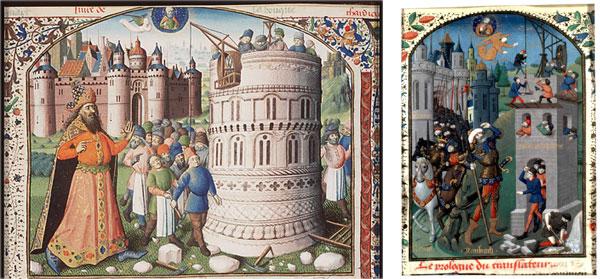
In the two illuminations above, Nimrod towers above the other figures, while God and an angel appear central and high, taking note of the mischief below. The presence of the angel explains God's plural direct address in verse 7, "Let us go down".
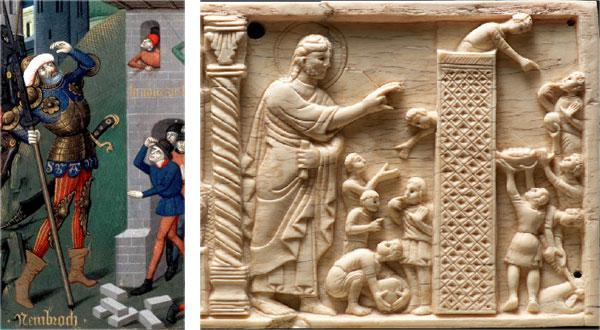
La cite de Dieu (detail) Salerno ivory, 11th cent.
The 11th century Solerno ivory (above, right) mocks Nimrod by showing God, rather than the human tyrant, beside the Tower. The Almighty is the real giant and he will undo this human folly.
In a parallel development in Midrash, Nimrod becomes the arch-pagan and arch-tyrant, who challenges God's authority, intent on reaching the celestial throne in order to displace the Almighty. L. Ginzberg compiles rabbinic Midrashim into the following account in which Nimrod and humanity are co-conspirators:
The iniquity and godlessness of Nimrod reached their climax in the building of the Tower of Babel. His counselors had proposed the plan of erecting such a tower, Nimrod had agreed to it, and it was executed in Shinar by a mob of six hundred thousand men.
However, Midrash rarely stressed Nimrod's gigantism; instead, it showed more interest in contrasting Nimrod's delusions of grandeur with Abraham's piety.
The Tower in Latter Days
Perhaps the most famous portrayal of the Tower is Bruegel's painting of 1563, once again featuring the giant Nimrod consulting with his builders at the base of a gargantuan edifice.
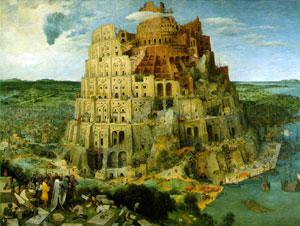
In fact, this painting is one of more than 100 16th century Dutch representations of the subject. This plethora of artwork has been variously interpreted as a critique of the Catholic penchant for cathedral building or of the tyranny of Spanish domination of Holland in that era, through analogy with Nimrod. In our own times, the Tower has sometimes become a symbol of unbridled urbanism and technology.
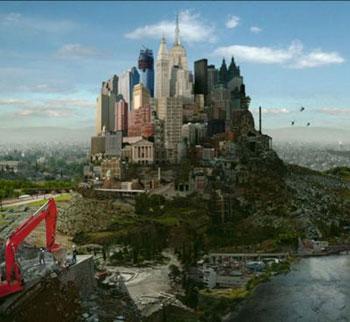
God's response
Just as the diagram above of the story's verbal structure has a crescendo and decrescendo, so the illustrations below portray heightened action from above and below terminating in desolation and diaspora.
First, the scenes of God's involvement, initially looking things over and subsequently doing battle together with his heavenly hosts.
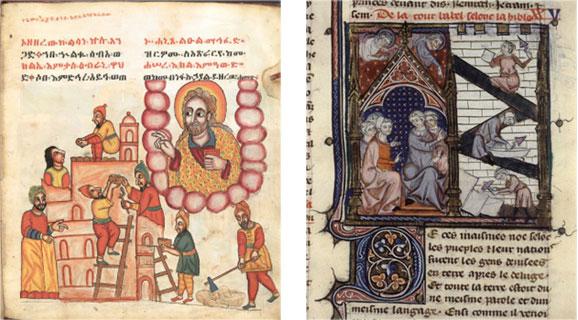
In the 18th century Ethiopian illustration, God is suspended within a necklace of clouds, gesturing to indicate speech, while looking quizzically at the builders of the Tower. Likewise, God speaks in the 14th century Bible Historiale, also accompanied by an angel.
In the 11th century Old English Hexateuch, God, standing atop one of the builders' ladders, observes from heaven.
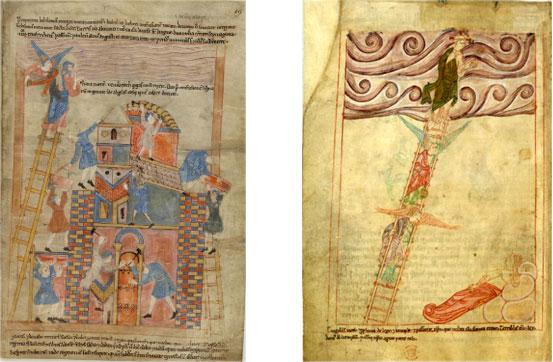
In a later chapter of the same manuscript, once again a divine figures stands astride a ladder, ascending from the earth to heaven, but this time it is Mary, viewing the sleeping Jacob.
What is the relationship between these two stories that creates similar iconography? Both narratives speak of an ascent to the heavens. Verbal clues also link the two stories: in both, we find the term "its head in heaven" and in both we find reference to gates. In Genesis 28, Jacob exclaims that the site of his dream is "the gate of heaven". In Genesis 11, the name "Babel" is derived from the word for confusion, but in fact this Semitic word means "the gate of the gods". At this point, meaning diverges: Jacob's visionary ascent is a spiritual journey on the axis mundi; the Babel tale is a satire on the futile efforts of humanity to attain fame and eternity through technology. Likewise, the two illustrations diverge: the celestial figure in the Tower of Babel scene is the condemning God of Judgment, whereas in the Jacob's ladder scene, Mary represents the God of Compassion.
All Hell Breaks Loose
God does not remain a passive observer (see above the Salerno ivory). In the Bedford Book of Hours, two angels dive-bomb the tower and the workmen, the tower begins to crumble and the workmen, unable to understand one another, begin to brawl.
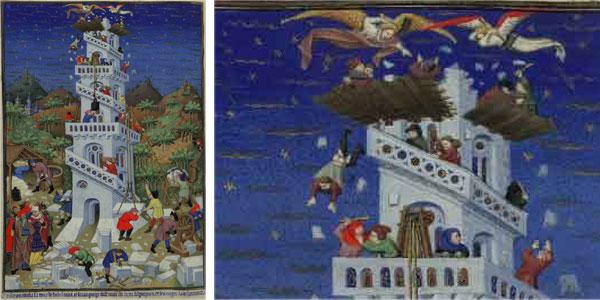
In the Golden Haggadah, as in several Midrashim, human violence is even more graphic, but the divine element, having passed its judgment, has disappeared.
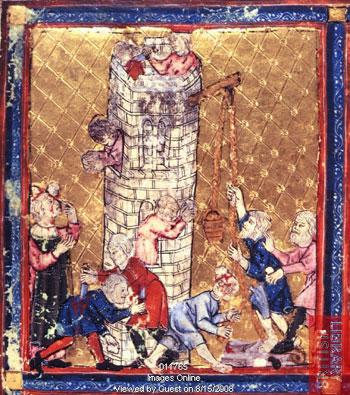
In Gerard Hoet's 18th century copper engraving, lighting strikes the Tower in a non-iconic divine presence, as the people battle below.

The story of the Tower seems to have also engendered one of the twenty-two signs of the Tarot, in which it represents the human ego whose false self-concept is threatened with destruction.
Gustave Dore's popular rendition of the scene has no violence, but rather panic and dismay among the workers, gathered at the base of the Tower under ominous clouds that seem to turn the Tower into a smoking volcano. There is a frightening similarity between Dore's image and the now iconic photograph of the Twin Towers.
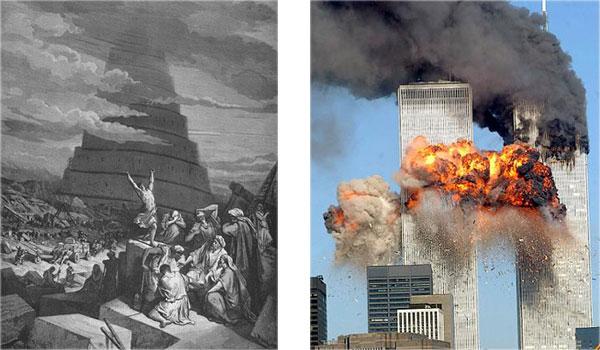
Gustave Dore, 1866 9/11
Don Isaac Abravanel's 16th century commentary on the Tower pericope strikes a contemporary note:
…the sin of the generation of the Dispersal was similar to the sin of Adam, Cain and his sons, in that despite being provided with all necessary provisions for their welfare, they were unsatisfied and desired to try their hands and put their minds to all types of crafts in the building of a city and a tower within it, in order to be unified there and become urban, rather than rural…the city being characterized by the urge to acquire property, theft and murder, as opposed to the agrarian lifestyle.
Both the attack on the WTC and Abravanel's reading of the Tower legend are radical rejections of technology and Progress. They differ, of course, in their vehemence and concern for human life. But the intent of the biblical account seems, rather, to be a warning about the inherent dangers of materialism and a call to balance the urge for progress with social and spiritual concern.
The 2004 memorial to the Towers was a totally non-material Tower of Light, perhaps illustrating our current inability to arrive at such a balance.
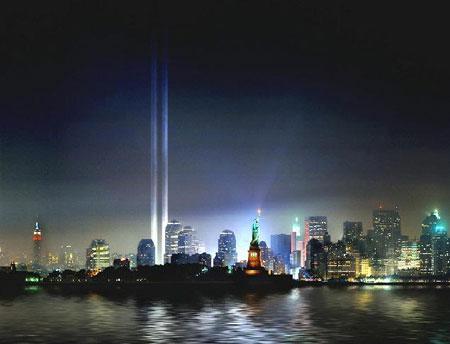
We have seen a variety of literary and visual understandings of the story of the Tower of Babel. But when we return to the story in its present setting in Genesis, as we noted, it seems to be describing how humanity scattered over the "face of the earth" from an initial situation of being all in one place. In a recent article, T. Hiebert suggests that our story is not concerned with sin and punishment, but with the tension between the natural human desire to remain united and uniform and the Divine will that humanity diversify and fill the entire world. Thus the answer to our initial quandary regarding the sin of the Tower builders is that there was no sin. The so-called punishment is, in fact, none other than the grand design of Genesis, in which there is a gradual zeroing in on a particular people, the seed of Abraham, chosen by God to confront the evils of humanity; for this purpose, humanity must first diversify. We have yet to see in the artwork on the Tower of Babel a visualization of this tension and the far reaching focus on chosenness, a challenge to artists of our time.
For additional images on this subject see TALI Visual Midrash



